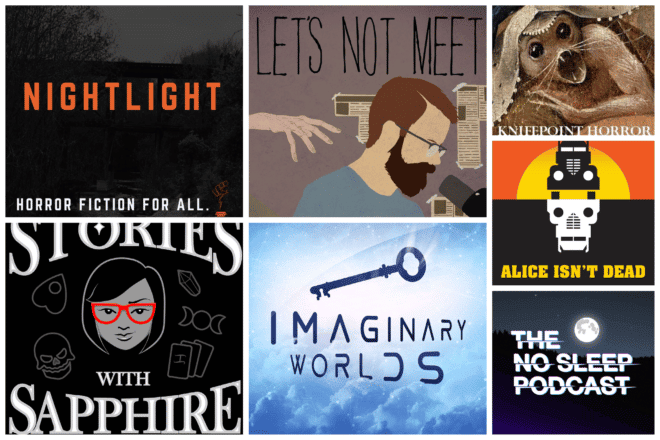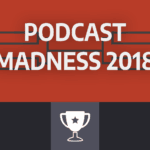How Horror Podcasts Provide Catharsis

Last updated on May 18th, 2021
The word “horror” covers a lot of ground, be it through its broad appeal, diversity of creators and subject matter, or the many mediums through which it can appear. There is subtle horror, gory horror, true horror, horror comedy, and countless other subgenres. A good horror story can make you feel sad, thoughtful, scared, or it can even make you laugh. People build friendships and memories through a shared love of horror. It plays a big part in a lot of people’s lives.
Perhaps then it should come as no surprise that horror has always had a home in the auditory realm. Even before radio existed, the tradition of telling scary stories goes back as far back as anyone can remember. While conversations around what exactly it is that people get out of horror might be as old as the genre itself, the world of horror podcasts has only added more nuance to these questions. An increase in audio platforms for horror has led to unique new scares, but it also presents its own challenges, and it’s own benefits.
Read more: Seven Horror Audio Drama Podcasts (Beyond “The Black Tapes”)
Horror is helpful?
Many horror writers and critics alike have written about the genre helping them through anything from insomnia to coping with difficult emotions to fear of the dark. According to Andrew Tate from the Let’s Not Meet: A True Horror Podcast, “I think horror is very helpful. There are studies that show it is healthy for your brain and your body to experience horror in some fashion.” Indeed, conversations about the potential cathartic qualities of horror have been written about in magazines as seemingly disparate as Time Magazine and National Geographic.
Apple Podcasts | Stitcher | Website
In 2017, the Imaginary Worlds podcast’s “Healing Through Horror” episode spoke with director Steven Sheil and writer Aaron Orbey about the healing elements of horror. Sheil, director of the truly visceral Mum & Dad (2008), noted that, “For me, the landscape of horror films feels like the landscape of grief.” Meanwhile, Orbey, who wrote about the subject for the New Yorker in 2016, shared a story about watching The Babadook with his sister, and how the film seemed to affect them more profoundly than other theater-goers due to their shared experiences in childhood.
Apple Podcasts | Spotify | Google Podcasts
For Tonia Ransom, creator of the Nightlight podcast, which focuses on a wide array of fictional horror works from Black writers, “Horror has been very cathartic for me. I’ve experienced a lot of trauma and death in my life, and horror is my way of dealing with it—either by reading or writing. When I don’t write for a while, I can feel my mental health slip. It’s essential for me.”
Apple Podcasts | Pocket Casts | Stitcher | Website | RSS
For Sapphire Sandalo of Stories with Sapphire, which emphasizes shared stories of the paranormal, horror has a therapeutic effect and helps her release anxiety. “I’m an incredibly anxious person and I like to have definitive answers to everything, and the paranormal world sort of makes me feel comfortable sitting in the unknown.” She continues, “For a lot of anxious people it brings them comfort. Anxiety arises when you’re trying to control a situation, and these horror stories sort of prepare you how to handle any impending danger.”
Apple Podcasts | Pocket Casts | Stitcher | Website
What makes horror podcasts unique?
There are many different ways to tell a horror story, but the medium through which it is told is a part of the storytelling in and of itself. As to why they chose podcasts specifically, and why podcasts are specifically appealing, one part of the appeal is the way it taps into the imagination in a different way.
For Sandalo, “Podcasts can capture the feeling of sitting around a campfire and listening to spooky stories, where you only have your imagination to visualize everything, and I think that makes everything creepier too.”
As for Ransom, “I fell in love with old time radio while I was working as a web developer in the early 2000s, before podcasts had come into existence. It was great to have a story playing while I worked and I immediately wondered why we didn’t have radio shows anymore. I wanted to revive the medium, but knew it’d be tough considering I had no contacts or experience. Then, eventually podcasts became a thing and I realized it’d be so much easier to bring old time radio back. At the time, I hadn’t considered screenwriting, or the challenges of working in audio. I just thought it was a great way to tell a story—especially a horror story.”
As Tate puts it, “Being someone that has a hard time focusing on a book long enough to finish one, these radio shows (audio dramas) from the 40’s and the 50’s were a great way for me to drum up some really scary scenes in my imagination. When the horror podcast world really began to open up with shows like Alice Isn’t Dead, The No Sleep Podcast, and (my favorite) Knifepoint Horror, I knew I wanted to put my audio production skills to good use and start my own.”
Still, audio does present challenges. Says Ransom, “You can’t think about the story visually the way you do with every other medium. And dialogue has to do a lot of heavy lifting, without it feeling expository. It’s so rewarding when a story comes together precisely because it is more challenging than other mediums.”
Read more: In Frightful Corners: Exploring Horror in Non-Horror Podcasts
But there are unique benefits to podcasting, as well. Ransom goes on to note, “I think audio and print have the advantage of allowing the reader/listener to imagine what’s most horrifying for them, rather than what the author of the story intended.”
What will the future hold for horror podcasts?
As for what these creators of horror podcasts are looking forward to hearing more of from audio horror, the responses were as unique as the podcasts themselves. For Tate, “More minimalistic horror storytelling. That’s why I keep it simple with Let’s Not Meet. I feel like less is more when it comes to horror audio specifically. There’s often too much music, too many sound effects, or too much banter when you have multiple hosts involved. I think there are a perfect number of those kinds of shows out there already. I’ve even had a lot of those podcasters on my show to tell stories, and they do such a great job just telling a good horror story with no bells and whistles. No jokes, no commentary… just good old-fashioned storytelling.”
Meanwhile, for Ransom, the most enjoyable thing would be higher production values to create a. “I’d love to see more binaural work and more use of infrasound!” She continues, “It’s purported to make us feel uneasy and anxious, which of course ratchets up the horror factor. I’d also love to see more shows that produce episodes in the same cadence as old time radio did—weekly, with seasonal breaks, much like TV today. We’re very much in the realm of cable TV series cadence, but most shows don’t have a network TV cadence because 20-25 episodes is very difficult for most indie podcasters to maintain. Hopefully, we’ll see more studios investing money in audio that allows creators to expand their seasons and production to more closely match ‘TV for the ears.’”
Meanwhile, for Sandalo, the future is all about building a stronger community. “Honestly, I just want to see not only more diverse stories being told but diverse hosts and creators. I am constantly trying to find other AAPI horror creators to collab with or promote and it is very difficult.”













Comments
Comments are closed.